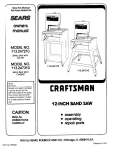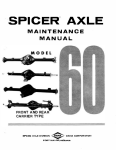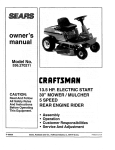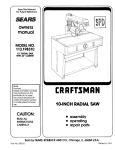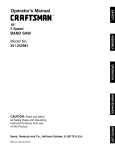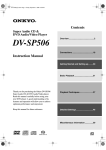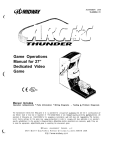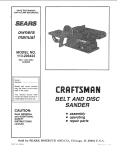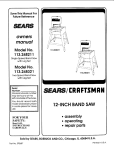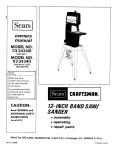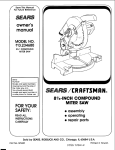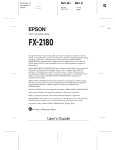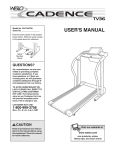Download Craftsman 113.247410 Owner`s manual
Transcript
f Save This Manual For Future Reference SEARS owners monuol MODEL NO. 113.247410 ELECTRONIC BAND SAW WITH CABINET & DOOR S_rial Number Model and s_rial nunnb_rs may b_ found at the I_t-hand side of the bas_. You should record both model and s_rial number in a safe place for future US_. CRRFTSMRN 12-1NCH ELECTRONIC BAND SAW CAUTION: READALL INSTRUCTIONS CAREFULLY • assembly • operating • repair pads J Sold by SEARS,ROEBUCKAND CO., Chicago, Part No. SP5085 IL.60684 U.SA. FULL ONE YEAR WARRANTY ON CRAFTSMAN BAND SAW If within one year from the date ol purchase, this Craftsman Band Saw fails due to a defect in material or workmanship, Sears will repair it, free of charge. WARRANTY SERVICE CENTER/DEPARTMENT IS AVAILABLE BY SIMPLY CONTACTING THROUGHOUT THE UNITED STATES. THE NEAREST SEARS SERVICE This warranty applies only while this product is used in the United States. This warranty gives you specific legal rights and you may also have other rights which vary from state to state. SEARS, ROEBUCK GENERAL SAFETY AND CO., DEPT. 698/731A Sears Tower, Chicago, IL 60684 INSTRUCTIONS 1. KNOW YOUR POWER TOOL Read and understand the owner's manual and labels affixed to the tool. Learn its application and limitations as well as the specific potential hazards peculiar to this tool. 2. GROUND ALL TOOLS This tool is equipped with an approved 3-conductor cord and a 3-prong grounding type plug to fit the proper grounding type receptacle. The green conductor in the cord is the grounding wire. Never connect the green wire to a live terminal. 3. KEEP GUARDS IN PLACE, in working order, and in proper adjustment and alignment. 4. REMOVE ADJUSTING KEYS AND WRENCHES Form habit of checking to see that keys and adjusting wrenches are removed from tool before turning it on. 5. KEEP WORK AREA CLEAN Cluttered areas and benches invite accidents. Floor must not be slippery due to wax or sawdust. 6. AVOID DANGEROUS ENVIRONMENT Don't use power tools in damp or wet locations or expose them to rain. Keep work area well lighted. Provide adequate surrounding work space. 7. KEEP CHILDREN AWAY All visitors should be kept a safe distance from work area. 8. MAKE WORKSHOP CHILD-PROOF -- with padlocks, master switches, or by removing starter keys. 9. DON'T FORCE TOOL It will do the job better and safer at the rate for which it was designed. 10. USE RIGHT TOOL Don't force tool or attachment to do a job it was not designed for 11. WEAR PROPER APPAREL Do not wear loose clothing, gloves, neckties or jewelry (rings, wrist watches) to get caught in moving parts. Nonslip footwear is recommended. Wear protective hair covering to contain long hair. Roll long sleeves above the elbow. 12. USE SAFETY GOGGLES (Head Protection) Wear Safety goggles (must comply with ANSI 2 13. 14. 15. 16. 17. 18. 19. FOR POWER TOOLS Z87.1) at all times. Everyday eyeglasses only have impact resistant lenses, they are NOT safety glasses. Also, use face or dust mask if cutting operation is dusty, and ear protectors (plugs or muffs) during extended periods of operation. SECURE WORK Use clamps ora vise to hold work when practical. It's safer than using your hand, and frees both hands to operate tool. DON'T OVERREACH Keep proper footing and balance at all times. MAINTAIN TOOLS WITH CARE Keep tools sharp and clean for best and safest performances. Follow instructions for lubricating and changing accessories. DISCONNECT TOOLS before servicing; when changing accessories such as blades, bits, cutters, etc. AVOID ACCIDENTAL STARTING Make sure switch is in "OFF" position before plugging in. USE RECOMMENDED ACCESSORIES Consult the owner's manual for recommended accessories. Follow the instructions that accompany the accessories. The use of improper accessories may cause hazards. NEVER STAND ON TOOL Serious injury could occur if the tool is tipped or if the cutting tool is accidentally contacted. Do not store materials above or near the tool such that it is necessary to stand on the tool to reach them. 20. CHECK DAMAGED PARTS Before further use of the tool, a guard or other part that isdamaged should be carefully checked to ensure that it will operate properly and perform its intended function. Check for alignment of moving parts, binding of moving parts, breakage of parts, mounting, and any other conditions that may effect its operation. A guard or other part that is damaged should be properly repaired or replaced. 21. NEVER LEAVE TOOL RUNNING UNATTENDED Turn power off. Don't leave tool until it comes to a complete stop. additional safety instructions for band saw Safety is a combination of common sense, staying alert, and knowing how your band saw works. BEFORE USING and lock knob, lower blade guide, tension adjusting knob and tension scale, and blade thrust bearing adjustment. THE SAW: 3. Read and understand operating procedures WARNING: TO AVOID MISTAKES THAT COULD RESULT IN SERIOUS, PERMANENT INJURY, DO NOT PLUG THE SAW IN UNTIL THE FOLLOWING STEPS HAVE BEEN SATISFACTORILY COMPLETED: 1. Assembly all safety instructions and throughout the manual. 4. Read the following labels which appear on the top of the band saw and blade guard. and alignment. 2. Learn the function and proper use of the on-off switch, bevel crank and lock, upper blade guide IDANGERI • Always wear safety with ANSI Z87.1. goggles • Before turning saw on, check a) Blade Tension b) Blade c) Thrust Bearings that comply and adjust: Guides FOR YOUR OWN SAFETY: • Before BLADE turning GUIDE saw on, adjust UPPER to just clear workpk_ce. • Support, fixture or brace workpi_e firmly against tlNble so it will not rock or twist from your hand, Know This Tool! Read • Plan hand positions won't cause injury, and Understand so a sudden • Turn saw Off and wait for bisde before freeing jammed material, INSTALLING OR MOVING 1. To avoid injury from unexpected saw movement: b. Adjust the saw so the table is level and the saw does not rock. c. Bolt the saw to the floor if it tends to slip, slide, or tip over during operations like cutting long, heavy boards. cord before 2. Store and use the band saw indoors. BEFORE before Using this to stop changing b_ad_s or leaving etoe. • Maintain V,e" maximum ¢kmrsnce table and sanding belt. Machine. and wait Mw, YOUR THE available at Sears retail or catalog stores. Use of glasses or use of goggles not in compliance with ANSI Z87.1 could result in severe injury from breakage of the eye protection. a. Place the saw on a firm level surface where there is plenty of room for feeding the workpiece. d. Turn saw off and unplug electric moving the saw to a new area. Manual • Turn saw off, m/hove switch key, for b_lKle to Ito_ before ad_uatlt_g WEAR WHEN SAW Owner's slip C. For dusty operations, with safety goggles. d Use extra caution with large, very small, or awkward workpieces. 1. Use extra supports (tables, saw horses, etc.) for any workpieces large enough to tip when not held down to the table top. , Do not feed small pieces that require your finger holding the workpiece to go under the guard area. Use jigs or fixtures to hold the work and keep your hands away from the blade. , When cutting irregularly shaped workpieces, plan your work so it will not pinch the blade. A piece of molding, for example, must lay flat or be held by a fixture or jig that will not let it twist, rock or slip while being cut. . Properly support round material such as dowel rods, or tubing. They have a tendency to roll while being cut, causing the blade to "bite." To avoid this, always use a "V" block, or clamp the workpiece to a miter gage. EACH USE 1. Inspect your saw. If any part of this band saw is missing, or bent, or failed in any way, or any electrical components do not work properly, turn the saw off, remove switch key, and unplug the saw. Replace damaged, missing, or failed parts before using the saw again. 2. Plan your work to protect you r eyes, hands, face, ears and body. a. Do not do layout, assembly, or set up work on the table while the saw is running. b. Wear safety goggles (not g lasses) that com ply with ANSI Z87.1 (shown on package). Using any power tool can result in foreign objects being thrown into the eyes, which can result in permanent eye damage. Safety goggles are wear a face shield along e. To avoid risk of hearing damage, wear ear plugs or muffs during extended periods of operation. 3 additional safety f. To avoid being suddenly caught in the blade: 1. Do not wear gloves. 2. Remove all jewelry and loose clothing. 3. Tie back long hair. 4. Roll long sleeves above the elbow. g. To avoid injury from accidental starting, always unplug saw, turn switch off and remove switch key before removing the guard, installing or removing any blade, accessory or attachment, or making any adjustments. instructions WHENEVER 2. Make sure the blade teeth point downward toward the table. 3. Make sure the blade tracking guides thrust bearings are properly adjusted. 4. Always check and correctly sanding belt tension. a. if your saw makes unfamiliar noise or if it vibrates excessively, stop immediately. Turn thesaw off. remove switch key and unplug the saw. Do not restart until finding and correcting the problem. b. Avoid awkward hand positions where a sudden slip could cause a hand to move into the blade or the sanding belt. c. Feed the workpiece only fast enough to let the blade cut without bogging down.or binding. d. Before freeing jammed material, turn saw off. Remove switch key. Remove plug from power source outlet. Wait for all moving parts to stop. e. When backing up the workpiece, the blade may bind in the kert (cut). This is usually caused by sawdust clogging up the kerf or because the blade comes out of the guides. If this happens: and adjust blade or i. To avoid accidental blade contact, minimize blade breakage and provide maximum blade support. 1. Turn saw off. 1. Always adjust the upper blade guide and blade guard to just clear the workpiece. 2_ Unplug 3. Remove 2. Plan your hand placement so your fingers will not be where a sudden slip could cause them to hit the blade. k. To avoid an electrical shock, make sure your fingers do not touch the metal prongs on the plug when installing or removing the plug to or from a live outlet. I. Never turn your band saw "ON" before clearing everything except the workpiece and related feed or support devices off the table. BEFORE SANDING 1. Keep the table and sanding belt adjusted so the gap between them is no more than 1/16-inch wide. 2. To avoid fire, shock, or cause electrical shorts, do not sand metal. It could ignite the sawdust inside the saw. saw. switch key. 4. Wait for all moving 5. Remove Make sure all clamps and locks are tight and there is no excessive play in any parts. j, IS RUNNING WARNING: DO NOT ALLOW FAMILIARITY (GAINED FROM FREQUENT USE OF YOUR BAND SAW) TO CAUSE A CARELESS MISTAKE. ALWAYS REMEMBER THAT A CARELESS FRACTION OF A SECOND IS SUFFICIENT TO INFLIC SEVERE INJURY. h. To avoid slips and jams causing injury: 1. Choose the right size and style blade for the material and the type of cutting you plan to do. Use this band saw to cut and sand only wood, wood like products and plastic. SAW parts to stop. band saw cover. 6. Stick a flat blade screwdriver the kerf. 7. Turn the upperwheel up the workpiece. f° or wedge into by hand while backing Before removing loose pieces from the table, turn saw off and wait for all moving parts to stop. ACCESSORIES To avoid injury from untested or improper accessories, use only Recommended Accessories listed on the Accessory page of this manual. table of contents Page 2 3 3 3 3 4 4 4 5 6 6 6 7 7 7 8 10 10 12 14 14 15 15 16 17 17 General Safety Instructions for Power Tools ....... Additional Safety Instructions for Band Saw ....... Before Using the Saw ........................ When Installing or Moving the Saw ............ Before Each Use ............................ Before Sanding ............................. Whenever Saw is Running .................... Accessories ................................ Glossary of Terms for Woodworking ............. Electrical Connections ......................... Power Supply ............................... Motor Safety Protection ....................... Wire Sizes ................................. Unpacking and Checking Contents .............. Tools Needed .............................. Table of Loose Parts ......................... Assembly and Alignment ....................... Assembling Cabinet ......................... Mounting the Motor .......................... Selecting Blade Speed ....................... Recommended Speed Settings ............... Connecting the Motor ........................ Mounting the Saw to the Cabinet .............. Mounting Door .............................. Attaching Trim Caps and Trim Ledge ........... Attaching Handwheel ........................ glossary cutting operation through the face of the Crosscut A cutting workpiece. operation made across Compound Cutting A simultaneous bevel and miter the width of the A sticky, sap based Used in reference to surface Freehand (as used for band saw) Performing a cut without the workpiece supported on the work table. speed properly sap based residue from wood Ripping A cutting piece. operation Sawblade Path substance or workpiece The distance the tip of the saw blade outward from the face of the blade. Kerf directly in cut or tooth is bent Trailing End The workpiece end last cut by the saw blade. Workpiece Leading End The end of the workpiece cutting tool first. which Mitering An angle cutting the workpiece. made across operation of the work- Set products. The material removed by the blade in a through orthe slot produced bythe blade in a non-through partial cut. of the that has dried. along the length The area of the worktable line with the saw blade. Gum A sticky, Resaw Resin operation. FPM Feet per minute. of blade. 19 19 19 19 20 21 22 24 27 27 27 27 27 28 28 29 29 30 30 31 31 31 32 36 Push Stick A device used to feed the workpiece through the saw during narrow ripping type operations so the operator's hands are kept well away from the blade. A cutting operation to reduce the thickness workpiece to make thinner pieces. cutting 18 of terms for woodworking Beveling An angle board. Page Getting to Know Your Band Saw ................ Location and Function of the Electronic Indicator System .............................. Digital Readout Display ...................... Function Keys .............................. Battery Cover ............................... Using the Electronic Indicator System .......... Installing the Blade .......................... Aligning the Blade and Blade Guides ........... Mounting the Front Table ..................... Squaring the Blade to the Table ............... Location and Function of Controls ............... On-Off Switch .............................. Tilting Head for Bevel Cut .................... Adjusting Bevel Lock Knob ................... Basic Band Saw Operation ..................... Circle Cutting ............................... Sawdust Collection .......................... Installing Sanding Attachment ................. Installing the Sanding Belt .................... Recommended Accessories .................. Maintenance ................................. Adjusting Band Saw Bevel Travel .............. Adjusting Upper Blade Guide Travel ........... Trouble Shooting .............................. Repair Parts .................................. is pushed into the the width of The item on which the cutting operation is being performed. The surfaces of a workpiece or common ly referred to as faces, ends, and edges. Worktable The surface on which the workpiece rests while performing a cutting or sanding operation. electrical POWER SUPPLY Motor Specifications The AC motor used in this saw is a capacitor-start, non-reversible type having the following specifications: MODEL NO. 113.247410 Rated H. P .................................... 5/8 Maximum Developed H.P ................... 1-1/8 Voltage ..................................... 120 Amperes .................................... 7.9 Hertz (Cycles) ............................... 60 Phase .................................... Sing le RPM ...................................... 1725 Rotation of Shaft ...................... Clockwise WARNING: TO AVOID ELECTRICAL HAZARDS, FIRE HAZARDS, OR DAMAGE TO THE TOOL, USE PROPER CIRCUIT PROTECTION. YOUR SAW IS WIRED AT THE FACTORY FOR 120V OPERATION. CONNECTTO A 120V, 1S-AMP, BRANCH CIRCUIT AND USE A 15-AMP FUSE OR CIRCUIT BREAKER. TO AVOID SHOCK OR FIRE, IF POWER CORD IS WORN OR CUT, OR DAMAGED IN ANY WAY, HAVE IT REPLACED IMMEDIATELY. IF NOT PROPERLY GROUNDED THIS POWER TOOL CAN CAUSE ELECTRICAL SHOCK -PARTICULARLY WHEN USED IN DAMP LOCATIONS CLOSE TO PLUMBING. IF AN ELECTRICAL SHOCK OCCURS THERE IS ALSO THE POTENTIAL OF A SECONDARY HAZARD SUCH AS YOUR HANDS CONTACTING THE SAWBLADE. NOT ALL OUTLETS ARE PROPERLY GROUNDED. IF YOU ARE NOT SURE THAT YOUR OUTLET IS PROPERLY GROUNDED, HAVE IT CHECKED BY A QUALIFIEO ELECTRICIAN. Your unit has a plug that looks like the one shown below. 3-PRONG PLUG PROPERLY GROUNDED OUTLET GROUNDING PRONG connections WARNING: TO MAINTAIN PROPER TOOL GROUNDING WHENEVER THE OUTLET YOU ARE PLANNING TO USE FOR THIS POWER TOOL IS OF THE TWO PRONG TYPE, DO NOT REMOVE OR ALTER THE GROUNDING PRONG IN ANY MANNER. USE AN ADAPTER AS SHOWN AND ALWAYS CONNECT THE GROUNDING PRONG TO KNOWN GROUND. It is recommended that you have a qualified electrician replace the two prong outlet with a properly grounded three prong outlet. An adapter as shown is available for connecting the plug to 2-prong receptacles. The green grounding lead extending from the adapter must be connected to a permanent ground such as a properly grounded outlet box. GROUNDING LUG ADAPTER MAKE SURE THIS IS CONNECTED TO A KNOWN GROUND 3-PRONG PLUG 2-PRONG RECEPTACLE WARNING: THE ADAPTER ILLUSTRATED IS FOR USE ONLY IF YOU ALREADY HAVE A PROPERLY GROUNOED 2-PRONG RECEPTACLE. MOTOR SAFETY PROTECTION CAUTION: To avoid motor damage this motor should be blown out or vacuumed frequently to keep sawdust from interfering with normal motor venUlaUon. 1. This tool should be connected to a 120V, 15 amp branch circuit with a 15 amp fuse or circuit breaker. Failure to use the proper size fuse can result in damage to the motor. 2. If the motor fails to start, turn the power switch to the "OFF" position immediately. UNPLUG THE TOOL. Check the saw blade to make sure it turns freely. If the blade is free, try to start the motor again. If the motor still does not start, refer to the "Motor Trouble-Shooting Chart." 3. If the motor suddenly stalls while cutting wood, turn the power switch off, unplug the tool, and free the blade from the wood. The motor may now be restarted and the cut finished. . This power tool is equipped with a 3-conductor cord and ground type plug listed by Underwriters' Laboratories. The ground conductor has a green jacket and is attached to the tool housing at one end and to the ground prong in the attachment plug at the other end. This plug requires a mating 3-conductor grounded type outlet as shown above. Frequent "blowing" of fuses or tripping breakers may result if: or circuit a. MOTOR IS OVERLOADED - Overloading occur if you feed too rapidly. can b. LOW VOLTAGE - Although the motor is designed for operation on the voltage and frequency specified on the motor nameplate, normal loads will be handled safely on voltages not more than 10% above or below the nameplate voltage. Heavy loads, however, require that voltage at motor terminals equals the voltage specified on nameplate. 5. Most motor troubles may be traced to loose or incorrect connections, overload, reduced input voltage (such as small size wire inthe supply circuit) or to overly long supply circuit wire. Always check the connections, the load and the supply circuit whenever motor fails to perform satisfactorily. Check wire size and length with the Wire Size Chart below. overheating and motor burn-out, use the table to determine the minimum wire size (A.W.G.) sion cord. Use only 3-wire extension cords have 3-prong grounding type plugs and receptacles which accepts the tools plug. below extenwhich 3-pole CAUTION: For circuits that are farther away from electrical service box, the wire size must be increased proportionately in order to deliver ample voltage to the saw motor. Length of the 120 Volts Wire Sizes Required Conductor (American Wire 0 - 25 Ft. 26 - 50 Ft. 51 - 100 Ft. Gage Number) 14 12 8 WIRE SIZES The use of any extension cord will cause some loss of power. To keep this to a minimum and to prevent unpacking and checking contents TOOLS NEEDED COMBINATION SQUARE MUST STRAIGHT EDGE BOARD 3/4-INCH THIS EDGE MUST f', j MEDIUM , PE R_CTLY SCREWDRIVER ., PHiW.s SC.EWO.,VER Ii_ 3/8" WRENCH 7/16" WRENCH 9/16" WRENCH COMBINATION DRAW LINE LIGHT ON ALONG BOARD THIS I EDGE J SQUARE L,_ / 7/16" SOCKET 9/16" SOCKET 1/8" HEX "L" WRENCH 5/32" HEX "L" WRENCH OF THICK BE STRAIGHT [ .... i '_.:!'. ','.'_i_;',i : _iIi BE TRUE _ SOCKET WRENCH SHOULD SQUARE WARNING: TO AVOID INJURY FROM UNEXPECTED STARTING OR ELECTRICAL SHOCK, DO NOT PLUG THE SAW IN UNTIL ALL ASSEMBLY AND ALIGNMENT STEPS ARE COMPLETE. THE POWER CORD MUST REMAIN UNPLUGGED WHENEVER YOU ARE WORKING ON THE SAW. Unpacking and Checking Contents 1. Separate all "loose parts" from packaging materials and check each item with "Table of Loose Parts" to make sure all items are accounted for, before discarding any packing material. l BE NO GAP OR OVERLAP HERE WHEN IS FLIPPED OVER IN DOTTED POSITION WARNING: IF ANY PARTS ARE MISSING, DO NOT ATTEMPT TO ASSEMBLE THE BAND SAW, PLUG IN THE POWER CORD, OR TURN THE SWITCH ON UNTIL THE MISSING PARTS ARE OBTAINED AND ARE INSTALLED CORRECTLY. . Remove front table and front cover first while saw is being unpacked. To remove the front cover, pull the cover at the neck and underside of throat area. unpacking and checking TABLE OF LOOSE contents PARTS |el 113.247410 Electronic Band Saw comes come in one carton and includes a cabinet with a sr shelf and door. ITEM AA BB ¢C GG HH II JJ LL DESCRIPTION QTY. Motor. Basic S';w'_;,em_)i_: :: :::: :: .......... --- • ...... 1 1 Owners Manual ............. Cabinet Assembly ........... _i_ ii ..... ..... Trim Cap, L.H. • "'""'" ..... --. ...... Trim Ledge Trim Cap, R.H.'_........................ ....................... Loose Parts Bag containing the following items: Band Saw Blade ....................... S'anding Belt 1/2 x 80 .................. Handwheel Assembly .................. Bag of Loose Parts #507655 ............ Bag of Loose Parts #507656 ............ Bag of Loose Parts #507741 ............ Battery ............................... NOTE: laying to the finish, 1 1 1 11 1 1 ! 1 1 1 1 To avoid damage to the band saw leave it on its left side until you are ready to mount it leg set or cabinet. To prevent scratching the lay a piece of the packing box u rider the saw AA CC o o o GG ! _lJJ_J HH _ JJ o BB LL LIST OF LOOSE PARTS IN BAG #507656 ITEM A B C D E R DESCRIPTION QTY. Truss Head Screw 1/4-20 x 1/2 ......... Lockwasher Ext. 1/4 ................... Hex Nut 1/4-20 ........................ Leveling Foot ......................... Hex Jam Nut 3/8-16 ................... Cover ................................. 34 34 34 4 8 2 A LIST OF LOOSE PARTS IN BAG #507655 ITEM DESCRIPTION F G H I J K L M N B C O P Pan Hal. Screw 10-32 x 2 ............... Hex Nut 10-32 ......................... Switch Key ............................ Lo Hd. Screw Cap 1/4-20 x 5/8 ......... Spacer #10 x 5/16 ..................... Hex Flange Lock Nut 10-32 ............ Locking Setscrew 1/4-20 x 1/2 .......... Wingnut 5/16-18 ....................... Pan Hal. Screw I/4-20 x 5/8 ............ Lockwasher Ext. 1/4 ................... Hex Nut 1/4-20 ........................ Hex Hal. Screw Ty TT 1/4-20 x 5/8 ...... Pan Hd. Screw Ty BT 1/4 x 1/2 ......... LIST OF LOOSE ITEM R S T U V W X Y Z PARTS OTY. 1 1 1 2 3 4 3 1 2 2 2 4 6 (_ _,\_\\_\\\\\_\\\\\\\\\\\\\\\\\\\\_ F H* IN BAG #507741 DESCRIPTION Sanding Platen ........................ Table Alignment Key .................. Table Latch ........................... Belt Tension Stud ..................... Poly"V" Belt .......................... Poly"V" Pulley ........................ Table Latch Spring .................... Table Alignment Spring ................ Key 3/16 Sq. x 15/16 ................... QTY. 1 1 2 1 1 1 2 2 1 J K N L 0 P Q. llr U "NOT SHOWN TO SCALE 9 assembly and alignment ASSEMBLING 4 CABINET 1. Separate all "loose" parts from packing materials and check each item with "Parts List" to make sure all items are accounted for before discarding any packing material. From loose parts find the following ITEM 1 2 3 4 5 6 7 8 2 items: DESCRIPTION Right Side Panel ...................... Left Side Panel ........................ Lower Shelf ........................... Skirt .................................. Shelf Stiffener ......................... Corner Bracket ........................ Spacer ................................ Door ................................. QTY. 1 1 1 2 1 2 2 1 % 8 m 9 Bag of Loose Parts #507530 (In Cabinet Assembly) Containing Following Items: 9A Screw, Pan Hd. #6-10 x 1/2 .......... 9 B Screw, Pan Hd. Ty "T" 6-32 x 3/8... 9 C Screw, Pan Hd. #10-10 x 1/2 ......... 9D Catch Magnetic ..................... 9E Hinge Door ......................... 2 2 4 1 2 * NOT SHOWN TO SCALE 2. After layout of cabinet parts, take the lower shelf and turn upside down on floor. Small front flange should be pointing upward. o O O o O O LOWER SHELF 3. Locate the two (2) corner brackets, four (4) 1/420 x 1/2 truss head bolts, Iockwashers, and nuts. Attach the corner brackets to the front flange in holes as illustrated. Attach both corner brackets. . CORNER BRACKETS CORNER Locate the two (2) side panels, one (1) shelf stiffener, and six (6) 1/4-20 x 1/2 truss head bolts, Iockwashers and hex nuts. Place the right side panel on its back side as illustrated. Stand up the lower shelf on the rear flange and line up the holes on the corner bracket and shelf stiffener with the holes in the side panel. Mount the bolts in the three holes and tighten hex nuts with a 7/16-inch wrench or socket. Repeat procedure for left side panel. BRACKETS SHELF SHELF RIGHT SIDE PANEL STIFFENER REAR 10 ,_ 7/_ FLANGE \ SKIRT RIGHT 5. Locate the two (2) skirts, eight (8) truss head bolts, Iockwashers and hex nuts. Assemble the one (1) skirt to the front of the cabinet through the holes as illustrated. SIDE PANEL \ \ Stand the cabinet upright and assemble the rear skirt. Hand tighten nut only at this time. \ NOTE: After the saw is mounted to the cabinet, all the hex nuts should be tightened. This will allow easy alignment of the mounting holes. SKIRT SHELF LEFT SIDE PANEL 6. Secure rear of shelf to right side and left side panels using two (2) 1/4-20 x 1/2 truss head bolts, Iockwashers, and hex nuts. Hand tighten nuts only at this time. 7. Locate the right and left side spacers, the six (6) 1/4-20 x 1/2 truss head bolts, Iockwashers, and hex nuts. Position the spacer inside the right and left side panels and fasten in the three holes as illustrated. Tighten nuts with a 7/16" wrench or socket. SPACER 8. Locate the two (2) covers and attach to openings in the right and left side panels as illustrated. 13 1/4 - 20 x 3/4 RIGHT SIDE PANEL COVER 9. Locate four (4) leveling feet and eight (8) 3/8-16 hex nuts. Attach the leveling feet to bottom of side panels in front and rear as illustrated. Hand tighten hex nuts. WARNING: TO AVOID INJURY FROM UNEXPECTED SAW OR WORK MOVEMENT, LEVELING FEET MUST BE ADJUSTED SO THAT SAW DOES NOT ROCK. CABINET 10. To adjust leveling feet so the saw will set properly: a. Move saw to desired location. NUTS b. With 9/16-inch wrench loosen bottom nut. c. Back off top nut by hand. d. Raise or lower foot by adjusting using 9/16-inch wrench. bottom nut LEVELING FOOT e. Snug top nut against inside of leg by hand. f. Adjust all four feet as necessary then tighten all four bottom nuts using a 9/16-inch wrench. 11 MOUNTING THE MOTOR 1. Find the following parts: ITEM AA J K M U W V X DESCRIPTION Motor ................................. Spacer (1/40.D. x 5/16) ............... Flanged Locknut #10-32 ............... Wing Nut 5/16-18 ...................... Belt Tension Stud .......... ........... Motor Pulleyw/Setscrew ............... Poly"V" Belt .......................... Shaft Key 3/16 ........................ QTY. 1 3 4 1 1 1 1 1 *NOT SHOWN TO SCALE 2. Have the band saw positioned on its left side as unpacked. To prevent scratching the finish, lay a piece of the packing box under the saw. 3. Place the three (3) spacers onto the three motor studs as shown. Pay attention to where the oil plug is located. No spacer goes on the fourth motor stud. 4. Place the shaft key into the groove on the motor shaft. Align the groove in the pulley with the shaft key and install the motor pulley on the motor shaft with the setscrew boss toward the motor. The pulley has an internal shoulder that will position the pulley the correct distance on the motor shaft. 5. Place the Poly "V" belt into the motor mount as shown on the underside of the band saw. MOTOR %IOUN _ 6. Look at the motor mount and find the slot that is narrower than the other three. When mounting the motor, the motor stud without a spacer goes into this slot. SLOT 12 / | 7. Carefully position the motor so that the poly "V" belt is around the motor pulley and the four motor studs align with the slots in the motor mount. SPACE. ) II 8. Push motor studs through and install the flanged lock nuts to the three (3) motor studs with spacers. Start the flanged nuts by hand only at this time. MOTOR MOUNT i i MOTOR MOUNT 9. Install the threaded stud through the hole in the lower leg of the motor mount and over the motor stud as shown. Install the wing nut onto the threaded stud and turn wing nut until motor slides down tensioning the belt. THREADED ii STUD i _, MOTO. MOUNT/ 10. Install a flanged lock nut onto this motor stud. Tighten the flanged lock nuts, using a 3/8-inch wrench, until almost tight. NOTE: Do not over-tighten the flange nuts. The motor should slide in the grooves to allow tensioning of the belt. J 11. Install the wing nut on the threaded stud. i !// 12. Check that the poly "V" belt is on both pulleys being sure that it is centered on each pulley. 13. Check that the pulleys are in line by sighting down the side of the large pulley to see if it lines up with the small pulley. If the pulleys are not in line, loosen the setscrew holding the pulley on the motor shaft and position the pulley. A notch in the small end of the motor support is provided for access to the setscrew and belt. N \ FLANGED LOCK NUT WING NUT 13 14. Belt tensioning is done by tightening the wing nut which pulls the motor down. The motor slides on the three (3) spacers and is locked in place by the flanged lock nut at the threaded stud. Belt tension is important. Over tensioning may cause vibration while too little tension may allow the belt to slip under heavy loads. TIGHTEN FLANGE NUT AFTER TENSIONING BELT WITH WING NUT SELECTING BLADE SPEED The band saw has two speed settings: 3000 FPM for normal operation and 1500 FPM for operation requiring more control of the work piece. f When changing belt positions always remove the belt from the largest wheel first. When changing speeds from 1500 to 3000 FPM remove the belt from the band saw pulley first. When going from 3000 to 1500 FPM remove the belt from the motor pulley first. I I MOTOR 1500 RPM 3000 RPM I RECOMMENDED SPEED SETTINGS 1. 3000 Feet per Minute a. Basic Wood Cutting. b. Resawing Most effective with skip tooth, hook tooth, and regular tooth blades. 2. 1500 Feet per Minute a. Intricate Wood Cutting b. Veneers, Tile, Plastics c. Non-Ferrous Aluminum)* Metals (Brass, Copper, Most effective with blades that have 15 teeth per inch. CAUTION: This band saw will not cut steel, Steel cutting requires the blade speed to be 140 FPM. *Must use recommended blade for non-ferrous metals. 14 l J CONNECTING THE MOTOR 1. Next, the motor cord needs to be wired into the motor. Coming from the underside of the table will be a cord with a black, white and green wire. This is the motor cord. TERMINAL GREEN WARNING: FOR YOUR OWN SAFETY, NEVER PLUG THE SAW IN UNTIL ALL ASSEMBLY STEPS ARE COMPLETED. 2. Loosen the two screws holding the connector box cover on the back side of the motor. Swing the cover open. BLACK WIRE TO TERMINAL T1 3. Install the green ground wire by removing the green grounding screw and inserting it through the round metal terminal on the green ground wire of the motor cord. Reinstall the green screw into the hole from which it was removed and tighten securely. WARNING: TO AVOID ELECTROCUTION, NEVER CONNECT ANYTHING BUT THE GROUND WIRE (COLORED GREEN) TO THE GREEN SCREW. GREEN GREEN STRAIN GROOVE WIRE SCREW RELIEF WIRE TO TERMINAL T4 4. Insert terminal end of WHITE wire on spade terminal marked T4 on the motor. Push terminal firmly until seated. 5. Insert terminal end of BLACK wire on spade terminal marked T1 on themotor. Push terminal firmly until seated. 6. Close motor connector box being sure that power cord is seated in the largest strain relief groove and tighten box cover screws. 7. DO NOT plug in power cord. MOUNTING THE SAW TO THE CABINET 1. From loose parts bag find the following ware: ITEM DESCRIPTION A Truss Head Bolts 1/4-20 x 1/2 .......... B Lockwashers External 1/4 .............. C Hex Nuts 1/4-20 ....................... hardQTY. 4 4 4 o©c© 15 2. Place saw on cabinet so that holes in bottom of saw line up with holes in top of cabinet. 3. Install bolts, Iockwashers, and nuts as shown. Tighten securely using a 7/16-inch wrench or socket. The front two bolts hold the saw, lower wheel cover, and the cabinet together. Install these bolts from the bottom side. I 4. After the band saw has been mounted to the cabinet, go back and tighten all the nuts that were previously hand tightened using a 7/16inch wrench or socket. MOUNTING DOOR Tools needed: 7/16" wrench or socket and phillips screwdriver. 1. Locate the two (2) door hinges and four (4) 10-10 x 1/2 plastite screws. Mount hinges on either side of the door with phillips screwdriver. PANEL 2. Locate the four (4) truss head bolts, Iockwasher and hex nuts to attach door hinges to the side panel. Tighten hex nuts with a 7/16" wrench or socket. 3. Locate the magnetic catch, the magnetic catch stop plate, two (2) 6-10 x 1/2 pan head screws and two (2) 6-32 x 3/8 pan head screws. Attach the magnetic catch to the door with the two (2) 6-10 x 1/2 pan head screws using a phillips screwdriver. Attach the magnetic catch stop plate to the side panel opposite the side the hinges are to be mounted. Use the two (2) 6-32 x 3/8 pan head screws to mount top plate. Adjust the stop plate if necessary with phillips screwdriver for desired closure. MAGNETIC CATCH STOP PLATE MAGNETIC CATCH J DOOR HINGE DOOR 16 ATTACHING TRIM CAPS & TRIM LEDGE 1. Locate the two (2) trim caps, the trim ledge, and from loose parts bag six (6) screws 1/4 x 1/2. 2. Place the trim ledge against the bottom of the base, then reach through the base and secure the trim ledge with the two screws using a phillips sc rewd river. L PHI LLIPS SCREWDRIVER TRIM 3. Position the trim illustrated. caps in place LEDGE and hold as 4. Then reach through the base and secure the trim cap with the two (2) screws using a phillips screwdriver. Repeat procedure for other side. ATTACHING THE HANDWHEEL 1. From loose parts bag find one (1) pan head screw 10-32 x 2 and one (1) hex nut. Install the handwheel. Reach inside the base to the back side of the bevel mechanism and put the nut in place. Hold the nut in place with a finger. Install the screw through the center of the handwheel and tighten with a phillips screwdriver. 2. Hold the handle and pull the red release button with your finger to close the handle. 17 getting to know your band saw 1 WARNING 2 TENSION ADJUSTMENT KNOB \ LABEL COVER CRRFTSNRN 1 WARNING LABEL GUIDE BAR LOCK KNOB BLADE GUIDES MITER GAGE SLOT 4 3EVEL LOCK KNOB S 4 BLADE 6 BEARING GUIDES HANDWHEEL ON-OFF 5 SWITCH BLADE 6 GUIDES 3 ELECTRONIC/INDICATOR SYSTEM 7 BACK-UP GETTING TO KNOW YOUR BEARING BAND SAW 1. Warning Labels. 2. Tensions adjustment knob- Tightening the knob will increase the tension on the blade. Loosening it will decrease the tension. Clockwise to tension, counter clockwise to loosen. 3. Electronic Indicator System -Digital readout for blade tension, bevel angle and blade speed (FPM). 4. Setting Bevel Angle - Pull the bevel lock knob and adjust the band saw to the desired angle by turning the handwheel, then push in the bevel lock to secure. 5. Blade Guide Adjustment - The guides can be adjusted in or out for various widths of blades and locked in place by the set screws. 18 6. Lateral Blade Guide Adjustment - The guides can be adjusted sideways and locked in position by the capscrews to prevent the blade from twisting during operation. 7. Blade Backup Bearing Adjustment - The thrust bearings can be adjusted in or out for various widths of blades and locked in place by the setscrews. . Guide Bar Lock Knob - The upper blade guides should just clear the workpiece while cutting. Always adjust the guides before turning on the band saw and lock the guide bar by tightening the knob. location and function of the electronic indicator system BATTERY COVER RELEASE SLOTS BATTERY COVER ON/OFF • OPEN BATTERY OPEN • _ KEY j BEVEL ANGLE KEY ELECTRONIC MEASUREMENT BLADE TENSION KEY KEY (FT. PER MIN.) REFERENCE DIGITAL DIGITAL READOUT DISPLAY The Liquid Crystal Display, or LCD, on this saw gives the user the ability to accurately position the blade and monitor the set-up. The three functions displayed are: Bevel Angle - Shows the present angle of the blade to thetable. The _ key is used to set thezero degree point. Blade Tension - Displays the blade size for which the tension has been adjusted. Blade Speed - Displays the speed of the blade in surface feet per minute (FPM). NOTE: The function being displayed is indicated by an abbreviated name of the function in the left hand area of the display; either BEV, TEN, or FPM. BATTERY FUNCTION SET KEY READOUT DISPLAY KEYS The five keys located to the right of the display are the function keys. They are: [_-- Turns the display "On" or "Off" -- Selects the Bevel Angle display I-_-- Selects the Blade Tension display m Selects the Blade Speed display ["EFS'T i -- Sets the Bevel Angle to Zero NOTE: In order to extend battery life the display will shut off approximately five (5) minutes after the last key was pressed. COVER The Battery Cover covers the battery compartment. To.release the cover, insert a small coin into one of the release slots and twist. Remove the cover. 1. Installing the Battery The battery is supplied with the loose parts. It is a 6-volt, type J alkaline battery. Install the battery with the contact end down and the "+" terminal towards the left. Push the battery down and back until the top edge of the battery is caught under the ribs in the compartment. Do not force the battery. It if doesn't push in easily, remove the battery and check that it is positioned correctly. 2. Reinstall battery covery by inserting the tabs on the lower edge of the cover into the mounting holes in the control and pushing the cover into position. 19 USING THE SYSTEM ELECTRONIC INDICATOR 1. Setting the Bevel Angle Reference Point. 3. Blade Speed Whenever the battery is installed or a new zero point is desired, it is necessary to set the zero reference. Normally the zero reference is set with the blade vertical to the table. When the blade is in the desired position for the zero point do the following. a. Press the _ b. Press the _-_ key if display is off. key, then the _ c. Display should read: p,v 2. Selecting key. F! u .uj Blade Tension a. Press the _ key if display is off. b. Press the key. _ c. The digital display will show one of seven tension settings. Turn the tension knob until the correct read-out appears for the blade or sanding belt you have selected. Read-out L S .125 .250 .375 .500 E 2O Indicates correct tension for: Loose - no tension Sanding Belt 1/8" blade 1/4" blade 3/8" blade 1/2" blade Overtensioned The digital display will read out one of two starting speeds, depending on where the motor belt is positioned on the pulleys. The two starting speeds are 3000 FPM and 1500 FPM. The speed ranges for each starting point are: 3000 2800 *2600 2400 2200 2000 1500 1400 "1300 1200 1100 1000 The band saw motor will stall if the blade speed drops two steps* below operating speed. NOTE: It is important to maintain maximum cutting efficiency by keeping the blade speed as fast as possible. Do not feed the work piece too rapidly. It will overload the motor and stall the blade. INSTALLING THE BLADE 1. Remove the blade guard by loosening the two (2) mounting screws with a phillips screwdriver and lifting the blade guard upward. _UGA RO __ " BLADE II__-_-._ GUARD MOUNTING 2. Loosen the upper blade guide assembly and lower to approximately 3 inches above rear table and retighten lock knob. This is necessary to make adjustments to blade guide and back up roller bearing. GUIDE 3"-__ 3. Loosen the two capscrews that lock the upper blade guides using a 1/8-inch hex "L" wrench and separate them about 1/8-inch. Repeat the same step for the lower blade guides. _r [JJL_._ j /-.-- BLADEGUIDECAPSCREWS BLADE GUIDE CAPSCREWS 4. Loosen the setscrew which locks the blade guide support and push the support all the way back. Repeat for lower blade guide support. SETSCREW LOWER ____ GUIDE BLADE SUPPORT SET SCREW UPPER 5. Loosen the setscrew which locks the upper back up bearing and push the bearing all the way back. Repeat procedure for lower back up bearing. _ CAUTION: To avoid being scraped, if the blade should suddenly uncoil, wear safety goggles. Carefully uncoil the blade holding it at arms length. . Uncoil the blade. 7. Place the blade over the wheels with the teeth pointing downwards toward the table as shown. Make sure the blade is between the blade guides and is in the center of the rubber tires. NOTE: If the blade will not reach around both wheels, lower the upper wheel by turning the tension knob counterclockwise. ALIGNING THE BLADE GUIDE ASSEMBLIES AND BLADE This band saw comes equipped with a 1/4-inch blade. This band saw can be used with blades of width from 1/8-inch to 1/2-inch. The alignment steps must be followed for proper tension, blade guide, and bearing adjustments for each different blade. Refer to the blade usage section for the recommended blade size for best results du ring most band saw operations. NOTE; It is critical to the life of the blade that the following steps are followed. Premature blade breakage will result if these steps are omitted. i "3 1. Turn on the digital display and push the key. Turn the tension knob until the display reads .250. Turn the tension knob one additional turn. this will set the correct tension for a 1/4 inch blade. WARNING: TO AVOID INJURY FROM UNEXPECTED STARTING OR ELECTRICAL SHOCK, DO NOT PLUG THE SAW IN. THE POWER CORD MUST REMAIN UNPLUGGED WHENEVER YOU ARE WORKING ON THE SAW. 22 BLADE ON CENTERED RUBBER TIRE BEARING BACKUP SETSCREW 2. Turn the upper wheel by hand a few times and notice if the blade remains in the center of the ti re on the top wheel. TRACKING ADJUSTMENT SCREW If the blade moves away from the center of the tire while you are turning it, the blade is not tracking properly. The top wheel shaft is hinged so the blade can be tracked. Tilt the wheel by turning the tracking adjustment screw using a medium screw driver. (See illustration.) a. If the bladel moves toward band saw: the front of the Turn the tracking adjustment screw clockwise about 1/4 of a turn, as though you were tightening it. b. If the blade moves toward the back of the band saw: Turn the tracking adjustment screw counterclockwise about 1/4 of a turn as though you were loosening it. c. Check adjustment by turning wheel by hand. 3. The upper and lower blade guides support the blade and keep it from twisting during operation. Adjust blade guide support whenever blades are changed or replaced with a different width. 4. Push the blade guide support toward the blade and adjust the blade guides so they are about 1/32-inch from the deepest part of the blade teeth. This deep part is called a gullet. Tighten the set screw locking the blade guide support. Turn the upper wheel, by hand, checking the position of the blade guide support. NOTE: Letting the blade teeth hit the blade guides while using the band saw will ruin the blade. The set of the teeth and the sharpened edge of the teeth would be damaged. Proper adjustment of the upper and lower blade guide assemblies will prevent this from happening. BLADE Repeat procedure for lower blade guide support. BLADE 5. Slide the two blade guides evenly against the sides of the blade. Do not push the blade guides or pinch the blade guides against the blade. Rotate the upper wheel by hand so the blade travels downward. This leaves proper space for blade. Make sure one guide is not further from the blade than the other. Tighten both setscrews with a 1/8-inch hex "L" wrench. Repeat procedure for lower blade guides. NOTE: The backup bearings support the blade from the rear and will spin when the blade is pushed against them while you are cutting. As soon as you stop cutting, the bearings should stop spinning. GUIDE LGULLET II BACKUP BLADE GUIDE BLADE BEARING GUIDE 23 6. To insure the backup bearing is properly supporting the blade, push the bearing toward the blade until it almost touches it. Turn the upper wheel, by hand, checking the backup bearing to make sure it is not turning. If the bearing is turning the blade is too close. Move bearing slightly away from blade and tighten set screw with 1/8" hex "L" wrench. Turn upper wheel and recheck the bearing. Adjust again if necessary. °"°EI L BEARING I I BACKUP BEARING SETSCREW L H Z 7. Repeat procedure for lower backup bearing. 8. Turn upper wheel by hand and check the blade guides and backup bearings to make sure they are adjusted correctly. Make any readjustments if necessary. I I BACKUP ,L J 9. Install blade guard and tighten with phillips screwdriver. (See illustration, page 19.) FRONT COVER 10. Install the front cover. Rest top edge of cover on two latch springs along the top edge of back cover. Swing cover down into position, engaging the three other latch springs. Push the front cover into position on the back cover. Check that the lip on the front cover completely overlaps the lip on the rear cover. MOUNTING THE FRONT TABLE LATCH SPRING _____ _..<---_-- 1. Turn front table over. Locate the two (2) latch springs, two (2) alignment springs, and the four (4) 1/4-20 x 5/8 hex washer head thread forming screws. ' I 3. Locate the two (2) oval point setscrews 1/4-20 x 1/2 and use an 1/8-inch hex "L" wrench to install in the two holes, as illustrated, but do not allow the screws to extend beyond the underside of the table. ALIGNMENT "_ SPRING I 2. Install the two latch springs on the front table as illustrated using a 3/8-inch wrench or socket. Install the two alignment springs on the front table as illustrated using a 3/8-inch wrench or socket. 1/4 - 20 X 5/8 , FRONT HEX "L" WRENCH j,,.1/4-20 OVAL ='- X 112 POINT SETSCREW FRONT 24 TABLE TABLE PAN HEAD SCR EW 4. Locate the two (2) table latches, two (2) pan head screws, Iockwashers, and hex nuts. Install the table latches to the underside of the front of the base in holes provided. _ ' FRONT LATCH TABLE / ,__ LOCKWASHE R XNUT _...__ 1/4-20X 1 OW HEAD CAPSCREW 5. Locate the table alignment key and the two (2) 1/4-20 x 1 low head capscrews. Install the key under the rear table miter gage slot and install the two screws but do not tighten at this time. TABLE ALIGNMENT KEY 6. Mount the table to the base as follows: a. Hold the front edge of the table. Position the rear edge of the table so that the two flat springs slip under the two tabs on the rear table. b. Line up the miter gage slots in the front and rear tables. FRONT TABLE \ c. Push the front edge of the table backward and downward until the table snaps into position. 7. Use a 1/8-inch hex "L" wrench to adjust the two leveling setscrews to bring the rear edge of the front table up to the same height as the front edge of the rear table. TABLE LEVELING SETSCREWS 25 8. To keep the miter gage grooves in line, use a flat blade screwdriver against the head of one of the low head capscrews in the miter gage groove to force the table alignment key firmly forward into the notch in the front table. 9. While holding the alignment key into the notch, tighten the other capscrew. Remove the screwdriver and tighten the remaining screw. Check that the miter gage grooves line up. 10. Check the operation of springs and tabs by removing the front table and reinstalling. Remove the table by lifting up on two spring tabs under front edge of the table until springs are free, then pulling forward. SQUARING THE BLADE TO THE TABLE To assure repeatability and accuracy, it is important to square the blade to the table and adjust the 0° position stop. This will guarantee that the blade will return to the square position after the head has been moved for a bevel cut. 1. Locate the 1/4-20 x 1/2 oval point setscrew and use an 1/8-inch hex "L" wrench to install it in the hole located at the left front of the rear table. The setscrew has a lock patch that will make it hard to turn. 2. Slide the upper blade guard position and tighten knob. to its top ATION most 3. Release bevel lock by pulling out bevel lock knob under left front edge of table. 4. Place a combination square on the table against the blade. Adjust the position of the blade to the table by turning the handwheel. When the blade is flush against the combination square lock the bevel lock knob. Use a 1/8-inch hex "L" wrench to set the 0 ° stop. Turn screw until it makes contact with the frame. 5. Unlock bevel lock, bevel the blade, then return to 0 ° position. Push in bevel lock knob and recheck blade to make sure it is square to the table. NOTE: The combination square must be "true" -- see the beginning of the unpacking and checking contents section for checking the combination square procedure. 26 HEX "L" WRENCH location and function of controls ON-OFF SWITCH ! NOTE: The On-Off switch has a locking feature. This feature is intended to help prevent unauthorized and possibly hazardous use by children and others. 1. Insert yellow key into switch. ") _-- 2. To turn on, insert finger under end of red switch lever and pull end out. 3. To turn off switch, push red lever in towards the base. 4. WARNING: The locking feature provided is to help prevent unauthorized use of your saw. Always remove the yellow key and keep it in a safe place. To remove yellow key, hold thumb on the end of red lever to keep switch in "Off" position and pull yellow key straight out. 3 / TILTING HEAD FOR BEVEL CUT IMRN 1. Unlock bevel lock by pulling outon knob located under the left front edge of the table. 2. Turn handwheel counter-clockwise to increase the tilt angle of the blade. The digital display will read out the angle of the blade to the table. 3. Lock the bevel lock by pushing in on knob until it is fully seated when desired bevel angle is reached. BEVEL LOCK LOCK HANDWH! ELECTRONIC DISPLAY PANEL MOUNTING ADJUSTING / BEVEL LOCK KNOB The bevel lock knob is factory adjusted and set. If after repeated use it becomes necessary to adjust: 1. Pull the bevel lock foward and bevel the band saw to 25 degrees. 2. Use a 9/16-inch wrench or socket to adjust the locking nut behind the band saw mounting frame. Turn nut clockwise to tighten. 3. Recheck bevel lock knob and readjust if necessary. 9 LOCKNUT FRAME / BEVEL LOCK KNOB I22 HANDWHEEL 27 basic band saw operation WARNING: FOR YOUR SAFETY, COMPLY WITH ALL THE SAFETY INSTRUCTIONS ON PAGES 2-4 BEFORE USING THE BAND SAW. A band saw is basically a"curve cutting" is not capable of doing inside cutting. machine. It Your Craftsman Band Saw is not only capable of the usual band saw operations, but it can be converted into a sander as well. You can finish wood, certain compositions and plastics. Operation Cross Cutting Ripping Mitering Beveling Compound Cutting Circle Cutting Resawing Curve Cutting Recommended Blade Size (Inches) 1/4, 3/8, 1/2 112 1/4, 3/8, 1/2 1/4, 3/8, 1/2 1/4, 3/8, 1/2 See Chart Below 1/2 1/8, 1/4 It is also used for straight-line cutting operations such as crosscutting, ripping, mitering, beveling, compound cutting, and resawing. CIRCLE 1. Adjust piece. CUTTING the upper BLADE CIRCLE guides SELECTION CUTTING GUIDE FOR MINIMUM to just clear the work- 2. Use both hands while feeding the work into the blade. Hold the workpiece firmly against the table. Use gentle pressure, and do not force the work, but allow the blade to cut. 3. The smallest diameter that can be cut out is determined by the width of the blade. For example, a 1/4-inch wide blade will cut a minimum diameter of approximately 1-1/2-inch (see chart), 28 2 1/2"D CIRCLE DIM. BLADE SIZE SAWDUST COLLECTION 1. There is an opening provided in the rear of the bottom cover to attach a 2-1/2-inch hose from a wet/dry vac to control sawdust. COLLECTION ! OPENING INSTALLING SANDING ATTACHMENT _, NOTE: The sanding belt cuts very rapidly. Practice with some scraps of wood first before you attempt to sand your actual workpiece. 1. To install the sanding remove the front table, and the blade, UPPER EARING BACKUP SETSCREW belt and sanding platen, front cover, blade guard, 2. Use a 1/8-inch hex "L" wrench and remove the upper and lower right blade guides, The mounting screw used for the upper blade guide will be used to hold the sanding platen in place, 3. Loosen the setscrews that hold the upper and lower backup bearings in place and push the bearings all the way back. Tighten setscrews so bearings will remain. 4. Slide the sanding platen into the blade slot in the table and fasten to the upper blade guide assembly where the right blade guide mounts, tt may be necessary to loosen the left blade guide and slide it backwards until platen is in place, 5. Slide the upper sanding platen securely. left and \ UPPER BLADE IIDE ASSEMBLY blade guide towards the tighten mounting screw 6. Slide the lower left blade guide towards the sanding platen until the platen rests 1/8-inch away from the right edge of the slot in the work table. I SANDING PLATEN 29 INSTALLING THE SANDING BELT Install the sanding belt and adjust tension to the sanding position. (The letter "S" on the scale.) NOTE: Check the tension often when a new belt is installed. A new belt will stretch during use. . . . Rotate the upper wheel by hand (clockwise) to check the sanding belt tracking. Adjust tracking if necessary. (Reference the blade tracking section for tracking procedure.) SANDING BELT After tracking the sanding belt if the belt and the platen do not align loosen the upper blade guide support and slide the support in or out to align. Then tighten set screws to hold support and platen in place. It may also be necessary to adjust the lower blade guide support to align the blade guide with the sanding platen, recommended accessories Caster Set for Cabinet ................... 9-22254 Miter Gauge ............................ 9-29929 Hold-Down Clamp for Miter Gauge ....... 9-29928 Stop-Rods for Miter Gauge .............. 9-29924 Rip Fence .............................. 9-23402 Blades and Sanding Belts ............ See Catalog Circle Cutting Attachment ............... 9-23411 Power Tool Know How Handbooks Radial Saw (includes band saw section) .. 9-2917 Table Saw (includes band saw section) ... 9-2918 The recommended accessories listed here are current and were available at the time this manual was printed. 3O maintenance WARNING: FOR YOUR OWN SAFETY, TURN SWITCH "OFF" AND REMOVE PLUG FROM POWER SOURCE OUTLET BEFORE MAINTAINING OR LUBRICATING YOUR BAND SAW, Tires Pitch and sawdust that build up on the tires should be removed with a stiff brush or scraped off with a piece of wood. CAUTION: To avoid damaging the tires do not use a sharp knife or any kind of solvent. When the tires become worn they should be replaced. When replacing the tires, stretch them around the wheels but do not glue them on. ADJUSTING BAND SAW BEVEL TRAVEL If the band saw will not hold its position when at a bevel angle, and before the bevel lock is locked, or if it is difficult to change the bevel angle, an adjustment is necessary to correct the force required to bevel the band saw. To adjust the force required to bevel the band saw, locate the three (3) capscrews holding the frame to the motor mount. The capscrews are located in the recessed area behind the hub of the lower wheel at the 2 o'clock, 6 o'clock, and 10 o'clock positions. Use a 3/16-inch hexagonal "L" wrench that has a 4-inch leg, reach between the spokes of the lower wheel to the capscrews. Adjust the capscrews equally until the bevel action is smooth and the saw will hold its position before the bevel lock is locked. ADJUSTING TRAVEL THE UPPER BLADE GUIDE If the upper guide bar will not move up and down easily or falls when the lock knob is loosened, the following adjustment should be performed. 1. Remove the Guide Bar Lock Knob and the washer which is under it. 2. Using a 7/16" socket or wrench, tighten the nut which is under the washer to just tight. 3. Then loosen the same nut 1 turn. 4. Move the guide bar up and down to check for smooth movement while still holding its position when released. 5. Make further adjustments to the nut as required to get the guide bar to move smoothly and hold its position when released. 6. Reinstall the washer and Guide Bar Lock Knob. General Maintenance Keep your band saw clean. Remove the sawdust from the inside. Vacuum or blow out frequently. Do not allow filth to build up on the table, the guides or the back-up bearings. Clean them with Craftsman Gum and Pitch Remover. CAUTION: Do not immerse the backup bearings in the gum and pitch remover. Put a thin coat of paste wax on the table so that the wood slides easily while cutting. Light Bulb To replace the light bulb remove the front cover. Use a phillips screwdriver to remove the lens and replace the bulb. The light bulb is a 25 watt bayonet mount bulb. Motor Frequently blow or vacuum out any sawdust from the motor. Follow lubrication instruction on the motor label. WARNING: TO AVOID EYE INJURY FROM BLOWING DEBRIS, WEAR SAFETY GOGGLES WHEN BLOWING OUT SAWDUST. WARNING: TO AVOID ELECTROCUTION OR FIRE, IMMEDIATELY REPLACE A WORN, CUT, OR DAMAGED POWER CORD. Lubrication All of the ball bearings are packed with grease at the factory. They require no further lubrication. WIRE CONNECTOR (3 REQ) SWITCH -'_ BLACK /F BLAC K-__l_[ _ co.ow, LUO/ /111; LAMP CORD BLACK WH,TE "--.OTO. I O"O BLACK _ WIRING DIAGRAM 31 trouble shooting WARNING: FOR YOUR OWN SAFETY, TURN SWITCH "OFF" AND REMOVE PLUG FROM POWER SOURCE OUTLET BEFORE TROUBLE SHOOTING YOUR BAND SAW/SANDER. TROUBLE PROBABLE CAUSE REMEDY Blade does not run in the approximate center of the upper wheel. Blade does not run in the approximate center of the lower wheel. 1. Not tracking 1. Lower wheel not positioned correctly on shaft, 1. Reposition the wheel by loosening setscrew and slide wheel in or out to allow blade to run in center of wheel. Band Saw slows down when cutting. 1. Belt too loose. 1. Adjust belt tension, see Assembly Section "Installing and Aligning the Belt." 2. Stop feeding, and back up the material slightly, until the band saw speeds up. 3. Replace blade. 4. Slow down, trying to cut too fast. properly. 2. Cutting too small a radius. 3. Dull blade. 4. Overloading motor. 1. Adjust tracking, see Assembly "Installing the Blade." Section, Blades breaking. 1. Too much tension on blade. 2. Kink in blade caused by cutting too small a radius or turning the material too fast when cutting. 1. Adjust tension. See Getting To Know Your Band Saw. 2. Use correct cutting technique. See Basic Band Saw Operation Section. Blade dulls too quickly. 1. Blade guides set too close to teeth. 2. Gutting incorrect material. 1. Adjust upper and lower blade guides. See Assembly Section "Installing the Blade." Band saw vibrates. 1. Too much tension on motor belt. 1. Adjust according to "Installing Poly "V" Belt" section. 32 and Aligning trouble shooting -- motor NOTE: Motors used on wood-working tools are particularly susceptible to the accumulation of sawdust and wood chips and should be blown out or "vacuumed" frequently to prevent interference with normal motor ventilation and proper operation of the centrifugally-operated starting switch. TROUBLE Excessive noise. PROBABLE CAUSE 1. Motor Motor fails to develop 1. Circuit overloaded with full power. NOTE: lights, appliances and other motors. LOW VOLTAGE: (Power output of motor decreases rapidly with 2. Undersize wires or circuit too long. decrease in voltage at motor terminals. For example, a reduction of 3. General overloading of 10% in voltage causes power company a reduction of 19% in facilities. maximum power output of which the motor is capable, and a reduction i of 20% in voltage causes a reduction of 36% in maximum power output.) Motor starts slowly or fails to come up to full speed, Motor overheats. 1. Low voltage. 2. Windings burned out or open. 3. Starting switch not operating. 1. Motor overloaded. 2. Improper cooling (Air circulation restricted through motor due to sawdust accumulation. REMEDY 1. Have motor checked by qualified service technician. Repair service is available at your nearest Sears store. 1. Do not use other appliances or motors on same circuit when using the saw. 2. Increase wire sizes, or reduce length of wiring. See "Motor Specifications and Electrical Requirements" section. 3. Request a voltage check from the power company. 1. Request voltage check from the power company. Check size of circuit wiring. 2. Have motor repaired or replaced. 3. Blow out sawdust from motor. Have motor repaired. 1. Feed work slower into blade. 2. Clean out sawdust to provide normal air circulation through motor. See "Maintenance and Lubrication" section. Starting switch in motor will not operate. 1. Have switch replaced and request a voltage 1. Burned switch contacts check from the power company. (due to extended hold-in periods caused by low line voltage, etc.) 2. Shorted capacitor. 2. Have capacitor tested and replace if defective. 3. Loose or broken 3. Have wiring checked and repaired. connections. Motor stalls (resulting in blown fuses or tripped circuit breakers). 1. Starting switch not operating. 2. Voltage too low to permit motor to reach operating speed. 3. Fuses or circuit breakers do not have sufficient capacity. 1. Have switch replaced. 1. Motor overloaded. 2. Fuses or circuit breakers do not have sufficient capacity. 3. Starting switch not operating (motor does not reach speed). 1. Feed work slower into blade. 2. Install proper size fuses or circuit breakers. Check that wiring will handle load. Frequent opening of fuses or circuit breakers. 2. Request voltage check from the power company. 3. Install proper size fuses or circuit breakers. 3. Have switch replaced. Blow out sawdust. 33 trouble shooting -- electronics PROBABLE PROBLEM No display when !_ is pressed. . I ----1 !Display dark. . Display blanks a few minutes. Display fter shows _ - Clean battery contacts. dirty - Replace battery. Battery is 6 volt, size J, alkaline type. 3. Battery dead. 4. Digital display 1. Normal battery unit. display when is first installed 2. Bevel display ref-set. Display dim. ACTION - Adjust battery position in compartment. - Install battery. Battery incorrectly installed or missing. 2. Battery contacts or corroded, Display shows SUGGESTED CORRECTIVE CAUSE - Have electronics checked by qualified technician. Repair service available at nearest Sears Store. failure. - No action required. in - Follow procedure for setting bevel reference point in this manual. was not 3. Poor battery contact to indicator display leads causing intermittent power to display. - Clean battery contacts. Adjust battery position in compartment. 4. Digital - Have electronics checked by qualified service technician. Repair service available at nearest Sears store. display failure. 1. Low battery voltage. 2. Temperature below 32 ° F. - Allow saw to warm above 32 ° F. 1...... Temperature above 120 oF. - Allow saw to cool below 120° F. h - Replace battery. Battery is 6 volt, size J, alkaline type. 1. Normal. - Press _ 1. Head tilted too rapidly for digital display to monitor. - Reset bevel zero reference. key. Display should return. I_ E.E.E.EI Display will reset to zero but immediately shows when bevel is moved. j Display does not llchange when bevel !is moved. _. Encoder or digital display defective. 1. Wrong display selected. - Have electronics checked by qualified technician. Repair service available at nearest Sears store. function - Select 2. Encoder or digital display defective. - Have electronics checked by qualified technician. Repair service available at nearest Sears store. 3. Rib on lower slide not engaging encoder. - Have electronics checked by qualified technician. Repair service available at nearest Sears store. i 34 bevel function. trouble shooting -- electronics PROBABLE CAUSE PROBLEM SUGGESTED CORRECTIVE ACTION 1. Wrong display function selected. - Select FPM function. 2. Encoder or digital display defective. - Have electronics checked by qualified technician. Repair service available at nearest Sears store. Display changes back and forth between 3000 & 2800 in fpm function. 1. Slight variations in blade speed. - Normal. Display does not change when blade tension is changed. 1. Wrong display function selected. Display does not change when blade speed is changed. , , Display shows in tension function. in - Select _ function. Encoder or digital display defective. - Have electronics checked by qualified technician. Repair service available at nearest Sears store. Encoder not engaged with tab on actuator. - Engage tab of actuator 1. Blade too tight. with encoder. - Normal. Reduce blade tension. .E I 35 PARTS LIST FOR CRAFTSMAN 12-INCH ELECTRONIC MODEL 113.247410 \ \ 36 BAND SAW PARTS LIST FOR CRAFTSMAN MODEL 12-INCH ELECTRONIC 113.247410 BAND SAW Always order by Part Number - Not by Key Number FIGURE Part No. iKey No. 1 2 3 4 507830 9-26595 41815 81660O 5 STD582062 6 41711 7 805034 8 816419-2 9 41812 10 STD541431 11 STD551031 12 816364 13 816446 14 816437 15 '816350 16 808380-5 17 18 19 816433 816453 STD533110 20 21 22 23 24 25 26 27 28 29 30 31 816464 816429 808447-2 60128 ISTD541425 805552-20 816435 816444 808335-2 STD372252 816380 808380-1 32 814083-2 *Standard 1 - DRIVE ASSEMBLY Key No. Description Cover, Front w/Label tBlade, Band Saw Tire Screw, Sl. Hd. Set 5/16-18 x 2-1/8 *Ring, Retaining 5/8 Washer, Spring Bearing, Ball Wheel, Upper Ring, Retaining 1-3/8 *Nut, Lock 5/16-18 *Washer, 21/64 x 5/8 x 1/32 Support Assembly, Upper Wheel Screw, Blade Tension 3/8-16 x 10-1/4 Knob, Blade Tension Plate, Support Screw, Pan Hd. Plastite #8 x 3/4 Frame Plate, Pivot Support *Bolt, Carriage High Strength 5/16-18 x 1 Latch, Cover Cover, Rear Washer, Wave 3/8 x 3/4 x .016 Washer, 17/64 x 5/8 x 1/32 *Nut, Lock 1/4 Washer 17/64 x 1 x 1/16 Knob, 1/4-20 Socket, Light Retainer *Bulb, Light Lens Screw, Pan Hd. Plastite No. 6 x 3/8 _rNut, Push 5/!6 Hardware Item may be Purchased Part No. 33 34 816352 815865-2 35 816362 36 816356 37 816365 38 STD502502 39 808819-1 40 STD315485 41:814083-1 42 816379 43 60334 44 45 46 47 48 49 50 51 52 53 54 55 56 57 69059 STD580103 816387 STD315238 816363 816349 816358 816377 STD551037 816353 816361 109093 816388 813786-2 58 59 60 61 62 63 64 9-22361 816368 806607 816599 816599 816393 809727-3 SP5085 PARTS Description Trunnion Screw, Hex Wash Hd. 1/4-20 x 5/8 Slide Assembly, Lower (Includes Key #32 & 33) Shaft, Bearing Support Support, Guide *Screw Soc. Set 1/4-20 x 1/4 Ring, Retaining *Bearing Ball "JrNut, Push 5/16 Guide, Blade Screw, Socket Button Cap No. 10-32 x 3/4 Wheel, Drive *Key, 3/16 Sq. x 15/16 Shaft, Lower Wheel *Bearing, Ball Slide Assembly, Upper Follower Nut, Heavy Square 3/8-16 I ndicator, Tension *Washer, .380 x .750 x .03 Spring, Blade Tension Lock, Slide Bolt, Carriage 1/4-20 x 1-3/4 Guard, Blade Screw, Pan Cross Hd. Type "TT" No. 8-32 x 5/8 tBelt, Sanding 1/2 x 80 Platen, Sanding Label Trim Encoder Spd./Ten. Actuator Tension Cord Sensor Screw Flat Hd. Ty "T" 8-32 x 7/8 Owners Manual (Not Ills.) Locally. tStock Item - May be secured through the Hardware Department of most Sears Retail Stores or Catalog Order Houses. ,klf this part is removed, discard and replace with a new push nut. 37 PARTS LIST FOR CRAFTSMAN 12-INCH ELECTRONIC MOD EL 113.247410 BAND SAW 32 3O 29 L 3: i [_-----38 5 6 12 lO t J -14 _--17 • _7 r _ I 25 J i 1 REAR 38 VIEW OF CONTROL ELECTRONIC PANEL PARTS LIST FOR CRAFTSMAN MODEL Always order by Part Number FIGURE Key No. Part No. 1 2 816434 806O36-2 3 4 816420 810214-2 5 6 7 816371 816370 815865-2 Key, Table Alignment Spring. Table Alignment Screw, Hex Washer Hd. 8 9 10 11 816442 1816417 816438 iSTD512505 Type "TT" 1/4-20 x 5/8 Spring, Table Latch Cover, Bottom Base Assembly Screw, Pan Hd. 1/4-20 x 1/2 12 !3 t4 15 16 17 18 19 20 816441 STD541110 STD551225 816113 816403 STD511105 815863 STD541025 815935 21 63467 22 60419 23 815869 *Standard Hardware • Can also use these Eveready #539 Rayovac #867 Duracel #7K67 2 - BASE 24 25 26 Front Locking Set x 1/2 Rear Low Hd Cap x 5/8 Key, Switch *Nut, Hex 1/4-20 Screw, Pan Cross Type 1/4 x 1/2 Cap, Flag Terminal Screw, Pan Hd. Plastite No. 8 x t/2 34 Cap, Trim Part No. 815881 507749 _808380-2 STD522505 35 62204 36 STD375006 37 STD551210 38 65093 39 816404 40 816376 41 808380-1 42 43 44 45 m L.H. Item may be Purchased battery "BT" SAW - Not by Key Number 27 1816372 28 1816436 29 816448 3O 816888 31 169123-12 32 815868 33 816333-2 Latch, Table *Nut, Hex 10-32 *Lockwasher, Ext. 1/4 Switch, Locking Box, Switch *Screw, Pan Cross 10-32 x 1/2 BAND COMPONENTS Key No. Description Table, Screw, 1/4-20 Table, Screw, 1/4-20 12-INCH ELECTRONIC 113.247410 STD551008 STD551206 STD363539 816333-2 507655 507741 Description Cap, Trim R.H. Trim, Ledge w/Label Screw, Pan Hd. Plastite No. 8 x 3/8 Plate, Cover Cord, Switch Cord, w/Plug Cord, Motor Relief, Strain Relief, Strain Screw, Pan Hd. Ty TT 10-32 x 3/8 *Screw, Hex Wash Hd. 1/4-20 x 1/2 Clip, Cord *Connector, Wire *Lockwasher, Int. #10 Clip Wire Control, Band Saw Lid Battery Screw, Pan Hd. Plastite #6 x 3/8 *Washer 3/16 x 1/2 x 1/32 *Lookwasher Int. #6 eBattery Screw, Pan Hd. Ty "TT" 10-32 x 3/8 Bag of Loose Bag of Loose Parts (Not Ills.) Parts (Not Ills.) Locally. numbers: 39 PARTS LIST FOR CRAFTSMAN 12-1NCH ELECTRONIC MODEL 113.247410 BAND SAW 22 17 13 21 19 I* 18 41 42 ) 33 26 i0 31 30 32 I0 35 39 PARTS LIST FOR CRAFTSMAN MODEL Always FIGURE Key No. Part No. 1 2 3 4 5 6 7 8 816499 816386 816381 816384 816543 816382 STD571207 815865-2 9 10 11 12 13 14 15 16 17 18 19 20 21 22 23 9414202 805556-23 816452 60317 816443 816348 802392-38 805562-1 60208 60240 816360 816359 816465 _815774-3 160419 24 809372-18 *Standard *If 3 - BEVEL Hardware order by Part Number DRIVE AND Handwheel Assembly Knob, Bevel Lock Pinion, Handwheel Gear, Handwheel Cover, Bevel Gear Shaft, Bevel *Pin. Roll 1/8 x 3/4 Screw, Hex Washer Hd. Ty TT 1/4-20 x 5/8 Nut, Lock 3/8-16 Washer, .380 x .750 x .03 Spacer 9/!6 x 1/4 Washer, 21/32 x 1 x 1/64 Gear, Segment Pinion, Bevel Drive Spacer 1/2 x 2 Washer, .507 x 1.25 x .125 *Nut, Push 1/4 *Nut, Push 3/8 Cam, Bevel Lock Mount, Bevel Lock Spacer 1/2 x .59 Rivet 1/4 x 1-1/8 Screw, Pan Hd. Plastite No. 8 x !/2 SAW MOTOR MOUNT Pad No. 25 26 27 28 29 30 31 32 33 34 STD541110 1816504 !816354-1 !816422 STD580103 816407 STD503105 816439-2 1816612 60453 35 36 37 38 39 40 41 42 816390 816815 STD541631 816817 816354 816445 STD551012 815992-1 43 44 45 46 STD551125 STD502505 816405 808380-2 ASSEMBLY PARTS Description *Nut, Hex 10-32 Support Frame Washer, Plastic 2.53 x 6 x .03 Mount, Motor *Key 3/16 Sq. x 15/16 Pulley, Polyrib 2 Step *Screw, Set 5/16-18 x 1/2 Belt, Poty V Motor 1725 R.PM. Spacer, Motor #10 x 5/16 Mount Pulley, Polyrib 2 Step Stud, Belt Tension *Nut, Die Cast Wing 5/16 x 18 Nut, Hex Flange Lock 10-32 Washer, Plastic 3.8 x 6 x .03 Bushing, Rubber *Washer 17/64 x 1/2 x 1/32 Screw, Hex Socket Head Ty "TT" 1/4-20 x 3/4 *Lockwasher 1/4 *Screw, Soc. Set 1/4-20 x 1/2 Encoder Bevel Screw, Pan Hd. Plastite #8 x 3/8 Pan Hd. 10-32 x 2 Item may be Purchased this part is removed, BAND - Not by Key Number Key No. Description Screw, 12-INCH ELECTRONIC 113.247410 discard and replace Locally. with new push nut. 41 PARTS LIST FOR CRAFTSMAN 12-1NCH ELECTRONIC MODEL NO. 113,247410 BAND SAW 4 19 17 _ 13 17 18 16 I! _ 7 14 15 FIGURE 4 - PARTS LIST 23" CABINET Always order by Part Number- Key No, Part No. ii 1 2 3 4 5 6 7 8 9 10 11 12 805589-5 815900 815887 817151 !8161 11 !STD541025 STD551225 817108 STD541237 803835-1 815993 816063 *Standard 42 i Hardware Description i Key No. Not by Key Number Part No. i Screw, Truss Hd. 1/4-20 x 1/2 Skirt 23" Shelf, Lower 23" Panel Side R.H. Cover *Nut, Hex 1/4-20 *Lockwasher, Ext. 1/4 Spacer *Nut, Hex Jam 3/8-16 Foot, Leveling Bracket, Corner Stiffener, Shelf Item may be Purchased Locally. i 13 817150 14 815882 15 815934 16 8t6274-1 17 815933 18 1816274 19 STD600603 507530 507656 Description , i Panel Side L.H. Door, Cabinet Hinge, Door Screw, Pan Hd. Plastite 10-10 x 1/2 Catch, Magnetic Screw, Pan Hd. Plastite 6-10 x 1/2 _*Screw, Pan Hd. Ty "T" 6-32 x 3/8 Bag of Loose Parts (Not. Ills.) Bag of Loose Parts (Not. Ills.) NOTES im r --_ f 12-INCH ELECTRONIC BAND SAW owners manual SERVICE Now that you have purchased your 12-Inch Electronic Band Saw, should a need ¢,ver exist for repair parts or s_rvice, simply contact any S_ars Service Center and most S_ars, Rc_zbuck and Co. stores. Be sure to provide all pertinent facts when you call or visit. MODEL NO. 113.247410 The model numperofyour found on a plate attached the base. 12-Inch Electronic Band Sawwill b_ to your saw, at the left-hand side of ELECTRONIC BAND SAW WITH CABINET & DOOR HOW TO ORDER REPAIRPARTS WHEN ORDERING REPAIRPARTS,ALWAYS GIVE THEFOLLOWING INFORMATION: PARTNUMBER PARTDESCRIPTION MODEL NUMBER 113.247410 NAME OF ITEM 12-Inch Electronic Band Saw All parts listed may b_ ordered from any S_ars Sen/ice Center and most S_ars stor_s. If the parts you need are not stocked locally, your order will b_ electronically transmitted to a Sears Repair Parts Distribution Center for handling. k,._ J j Sold by SEARS,ROEBUCKAND CO., Chicago, Part No, SP5085 Form No, SPD085-I IL. 60684 U.S.A. Printed in U.S.A 12/87












































